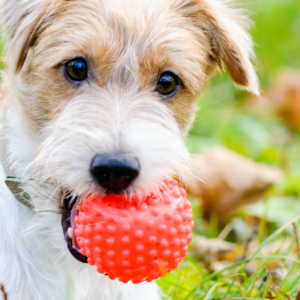The snow is melted, the days are longer, it’s warmer out and after many months cooped up in the house you and your pet are probably itching to get outside and play! Springtime is definitely the season to start spending more time outdoors but in our excitement to put away the winter parka and snow boots it’s important to not lose sight of certain pet hazards which accompany the warm weather and more time spent outside. We want to ensure your pet enjoys spring to the fullest so here are a few tips for keeping them happy and healthy all spring long!
Top 5 Pet Precautions for Spring
- Fleas
Yes, it’s that time of year again where parasites are emerging and looking for a host to live on or in. This is the season where most pets pick up fleas though they may go unnoticed for weeks, even months. Keep in mind that seeing live adult fleas on your pet is sign of a heavy infestation. Just one female flea lays up to 2000 eggs in her lifetime. By the time your pet has enough adult fleas to be noticeable there are many thousands of eggs in your home. The best way to avoid fleas is to start your pet on a flea preventative in springtime and keep them on it until winter. Be sure to buy flea products from an animal hospital and not pet stores or grocery stores. Veterinary products are formulated to be safe and effective; they are prescription drugs that have passed quality control. Products purchased elsewhere are all pesticides. The dose should be safe for your pet, however many of these over-the-counter products can be dangerous, especially if a dog product is used on a cat.
- Ticks
The prominence of ticks in New Brunswick is on the rise, and these parasites also emerge in spring. Ticks cannot fly or jump, instead they sit on top of blades of grass waiting to drop onto animals, or people, passing by. Woodlands and areas with tall grass are their primary habitat, so be sure to check your pet over well after a walk through the woods and remove ticks promptly. Different species of ticks carry different diseases that can affect both pets and people. In New Brunswick Black-Legged, or Deer, ticks are common, a species which transmits Lyme disease. Again prevention is the best way to protect your pet, and several veterinary products will protect your pet from both fleas and ticks. There is also a Lyme vaccine available.
- Trauma
Although accidents can happen any time of year the incidence tends to be higher in springtime. Unfortunately hit-by-car accidents are a hazard of springtime merely because there are more motorists on the road and more pets outdoors. Even if your cat is indoor-only and your dog is never off leash accidents can still occur. The best way to protect your pet is to be prepared. Pet insurance gives you peace of mind that in the event of an accident your pet will receive the care it needs, sparing you the heartache of making decisions based on finances. We strongly advise all pet parents to look into pet insurance, especially if you are thinking of adopting a new pet this spring.
- Injuries
Something pet parents don’t always think about is how a long winter of inactivity can affect their pet’s health. Just as people need to get back into physical activity slowly to prevent injuries so must our pets. A dog that’s spent all winter going on leashed walks and has perhaps put on a little extra weight then suddenly goes out to play frisbee the first of spring is more likely to succumb to a knee injury. With two orthopedic surgeons working at Riverview Animal Hospital we see many cranial cruciate ligament (CCL) ruptures in dogs. The CCL is similar to the anterior cruciate ligament (ACL) in humans, and provides stability to the knee joint, holding the tibia and kneecap, or patella, in alignment. Although CCL rupture is often associated with active dogs it is actually far more common among middle aged, overweight dogs who suddenly exert themselves. CCL rupture is a common cause of hind-end lameness, arthritis and pain. There is no full-proof way to prevent this injury but keeping your dog fit, active, and easing them back into physical activity at springtime can greatly reduce the risk.
- Wildlife & Plants
Keep in mind that not just parasites are emerging in spring but also animals, like porcupines, deer, squirrels, coyotes, raccoons, etc. Your dog or cat are far more likely to come in contact with these wild species this time of year and not all of these encounters are going to be friendly. It is not advised to let your pets roam free in areas wild animals are common nor is it advised to entice wild animals on to your property by offering feed. Rabies does exist in New Brunswick and raccoons are not the only carriers. Any mammal can become infected and can spread the fatal disease to your pet by transfer of saliva. There is no cure for Rabies and humans are also at risk. Not only disease but bite wounds and scratches from a wild animal can easily become infected or result in an abscess.
As the saying goes, ‘April showers bring May flowers’. Indeed the outdoors comes to life in springtime, everything is growing and blooming. However not all plants growing in your backyard are harmless. Many common plants are actually toxic to pets, some even deadly. Things to look out for are foxglove, aloe, lilies, and rhubarb although these are just a few of a long list of toxic plants that your dog or outdoor cat may have easy access too. Always contact your veterinarian or a pet poison control center if you suspect your pet has ingested a toxic plant, or if you’re unsure whether the plant they’ve ingested is toxic.
We hope these tips keep your pets safe this spring, and from everyone at RAH enjoy a happy, healthy, and fun-filled springtime!
Resources: www.petpoisonhelpline.com
Written by Riverview Animal Hospital




